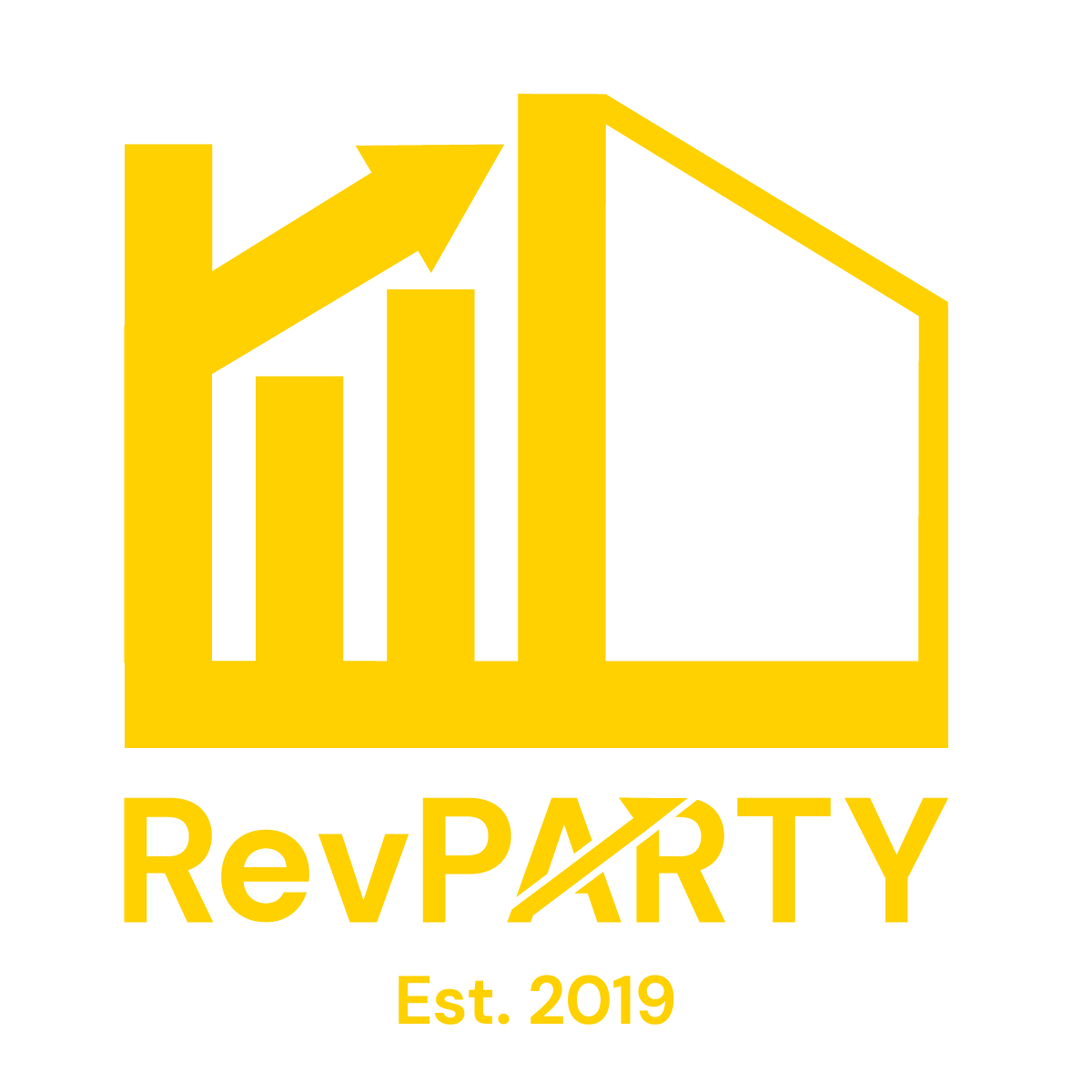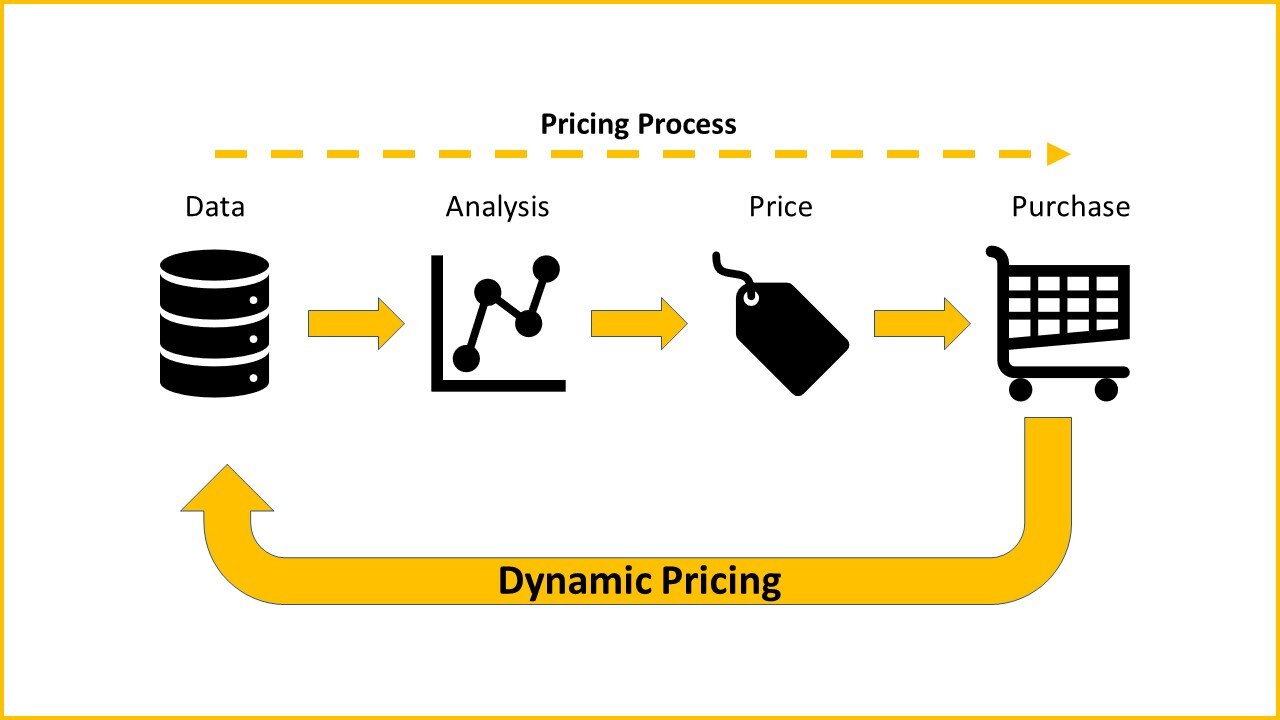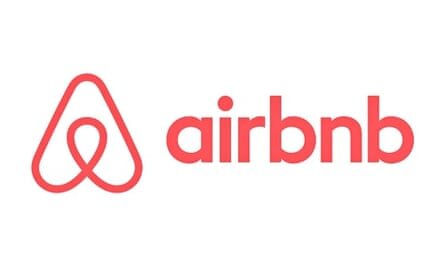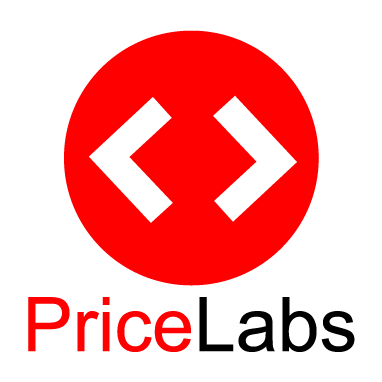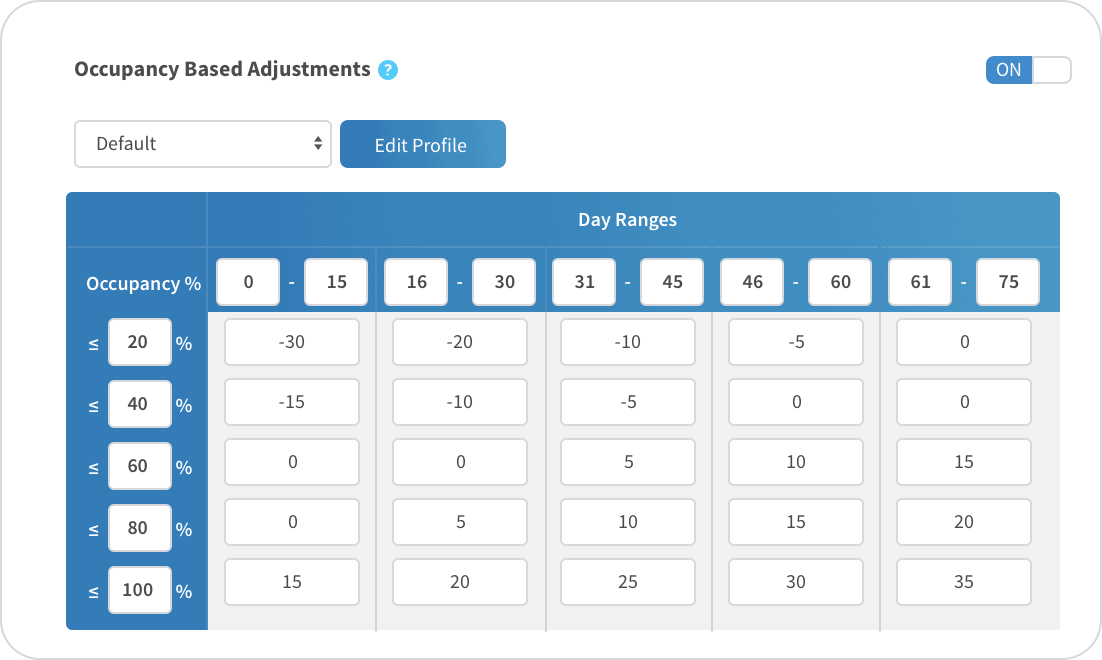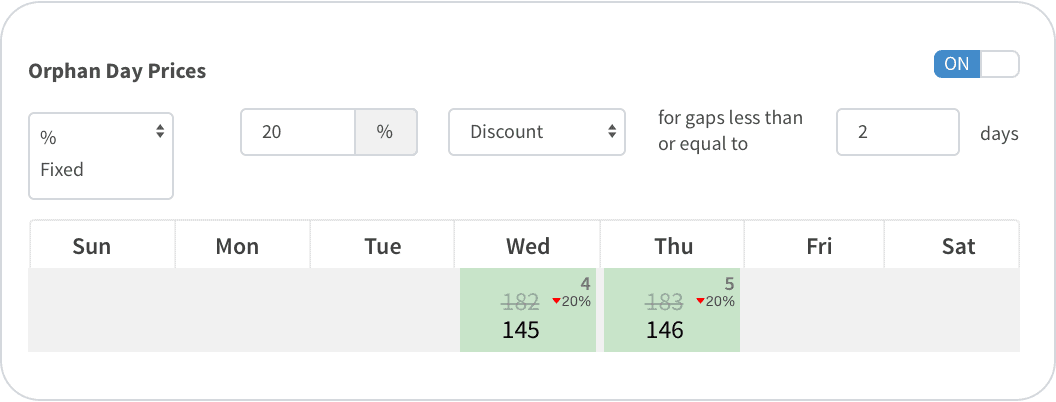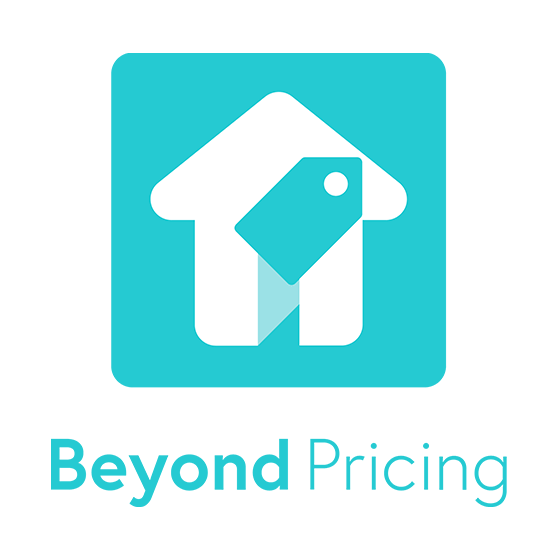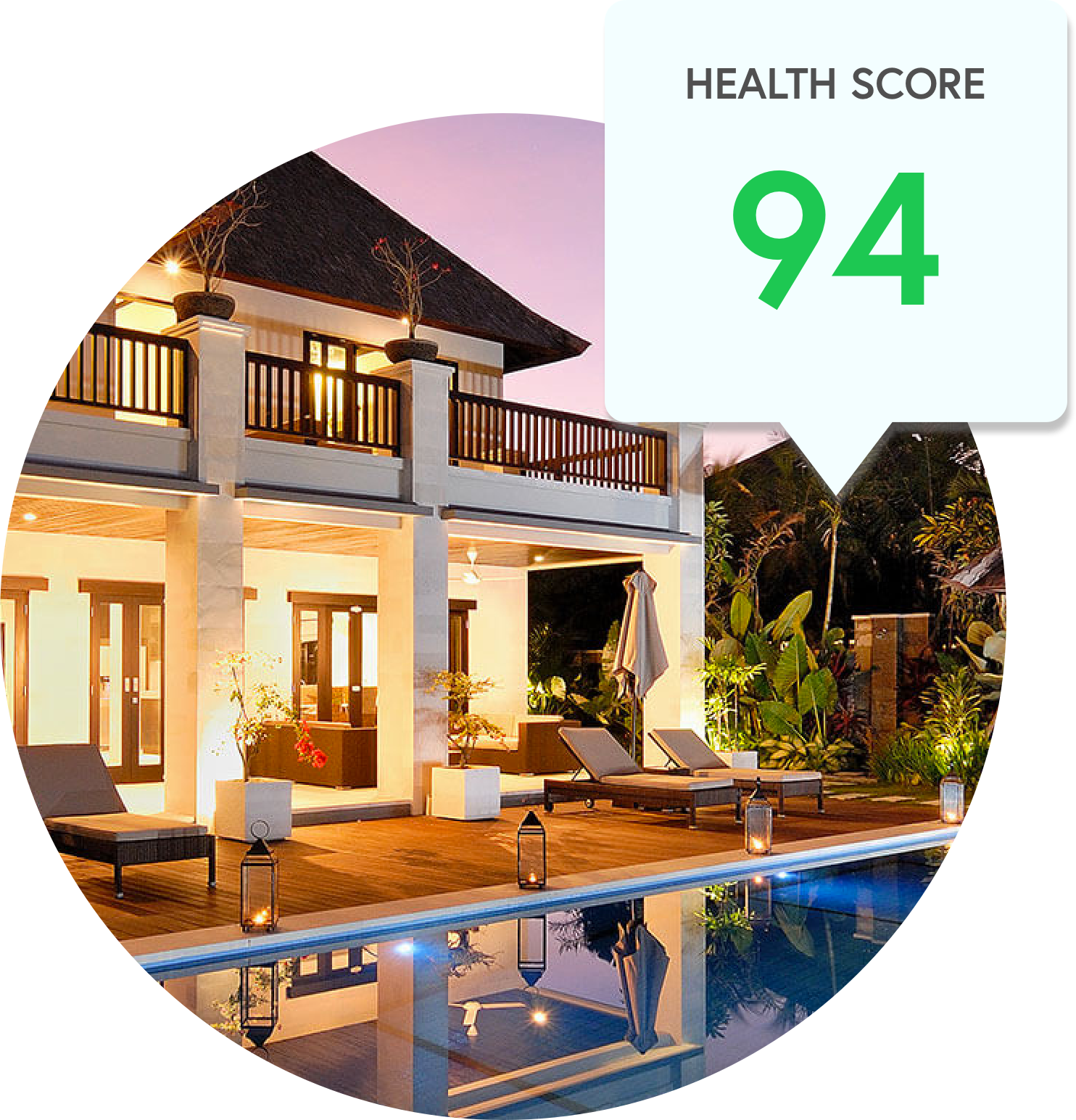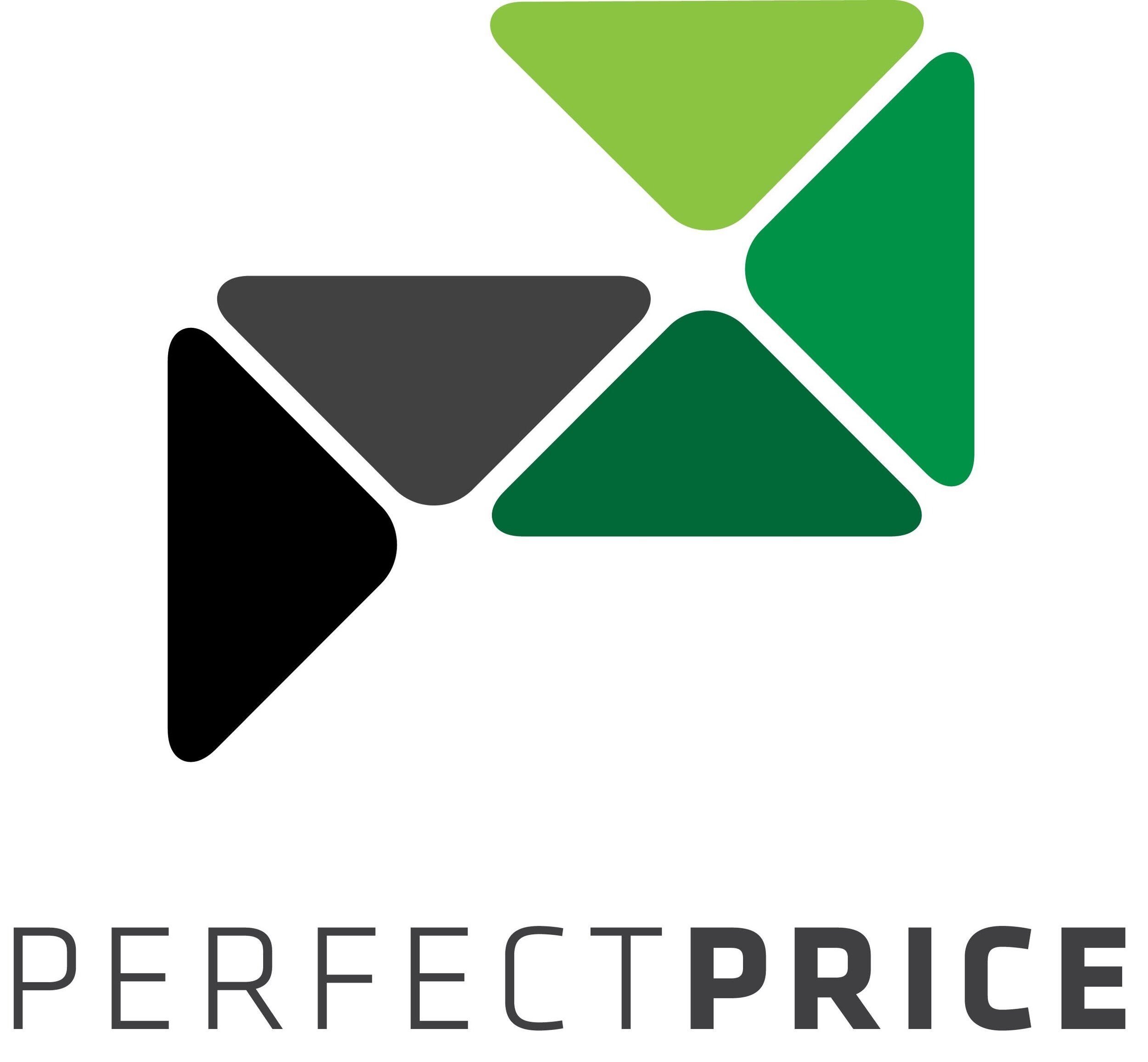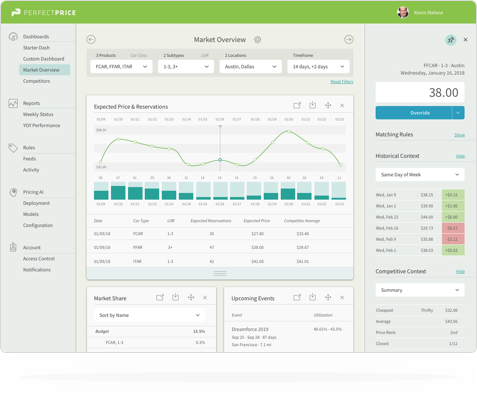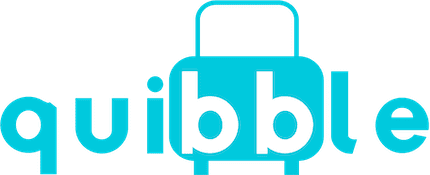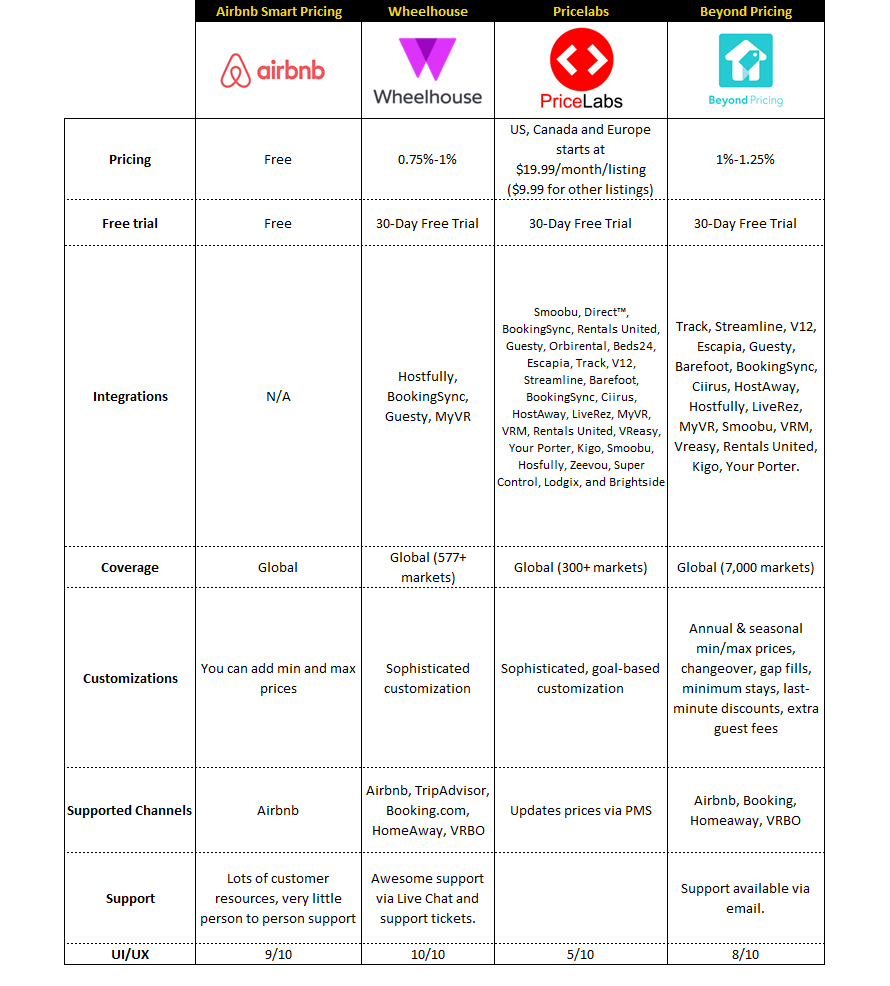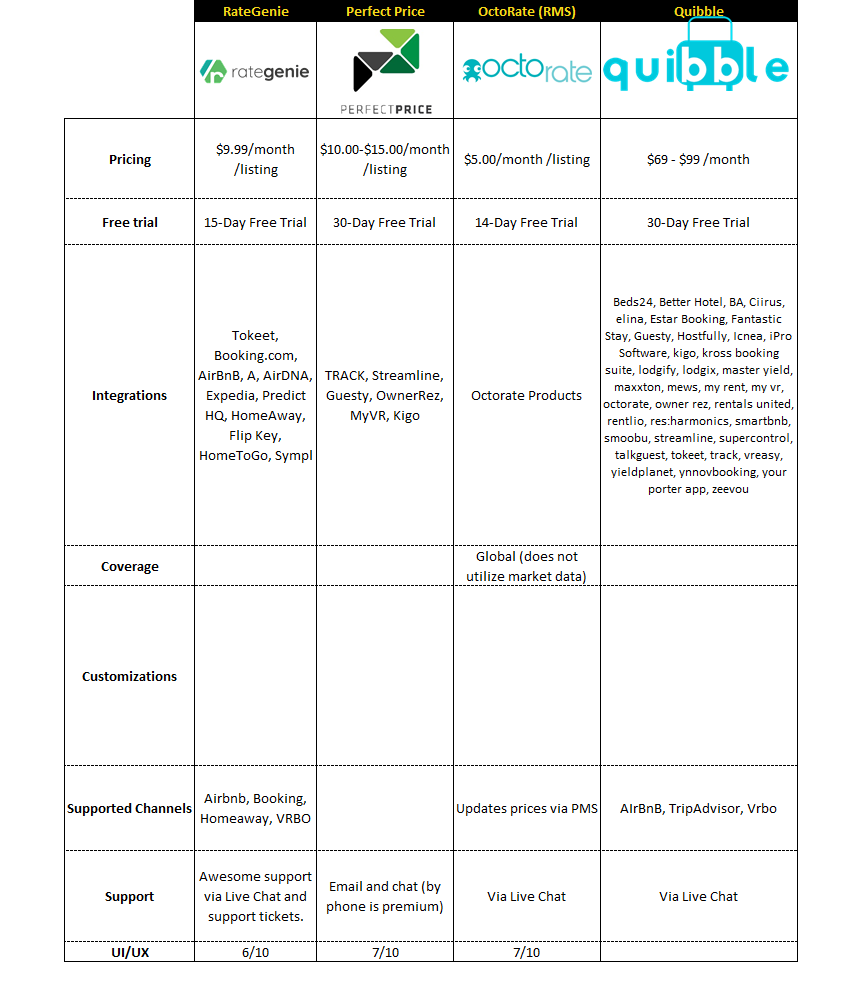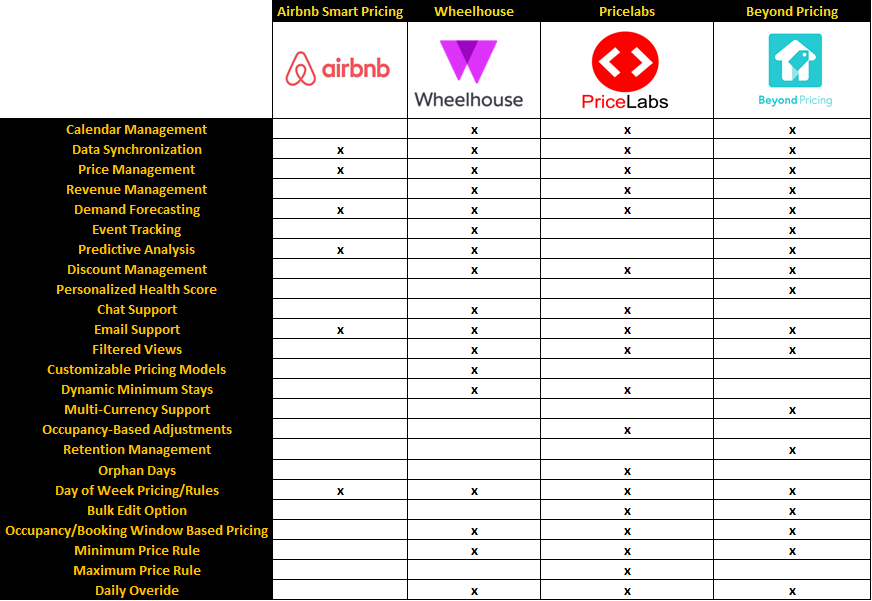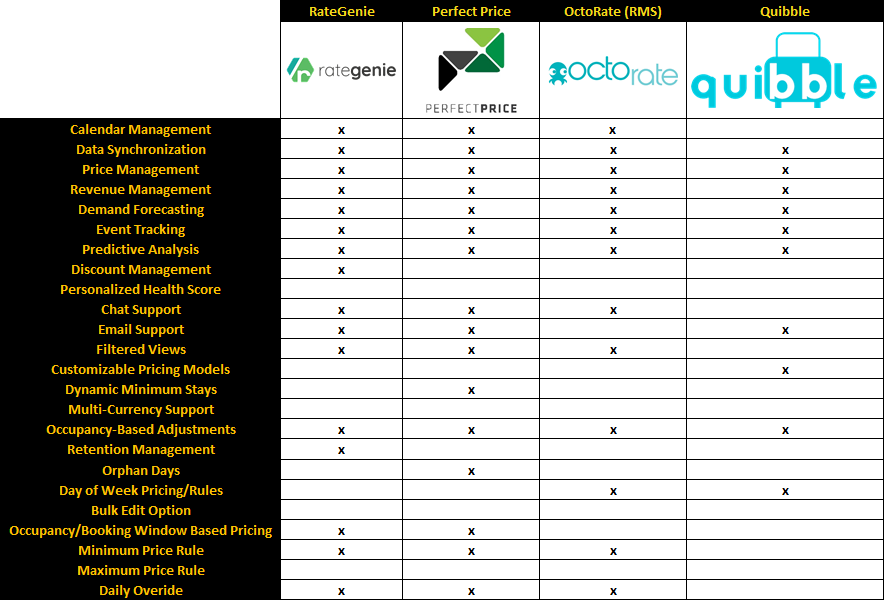Its hard being a vacation rental manager! If you’re a solo operation than you’re wearing multiple hats as you take care of guest communication, cleanliness and quality control, arrival and departures, reputation management, accounting, and all of the software and systems needed to be competitive in today’s market. And that doesn’t even include revenue management!
Pricing, stay restrictions, discounting and promotions, channel distribution, marketing, and data analytics are all parts of revenue management and can easily slip through the cracks. Even if you have a capable person (or team) that focuses on revenue management, it is still much harder for a vacation rental to implement a pricing strategy compared to traditional businesses like hotels and airlines (for an in depth dive as to why check out “The Difficulty with Data”).
But just because its hard isn’t an excuse to ignore it. Some case studies have shown that implementing dynamic pricing can increase revenue by up to 40%. Here at RevPARTY, we’ve had clients that were already using automatic pricing tools but after some revenue management consulting saw revenue increase by 25%. There’s just too much money left on the table if you don’t use dynamic pricing.
Luckily, many great minds have set out to solve this problem: increasing revenue through pricing with limited time. There are multiple tools available in the vacation rental marketplace that help vacation rental managers effectively and efficiently price their units.
You may not be a revenue management or data analytics expert. We know you’re hard-pressed for time and don’t want to spend hours researching and attending demos. But don’t worry, RevPARTY is here to help you claim back your money and your time. Below we provide a dynamic pricing overview, a review of several pricing platforms, and then a side-by-side comparison to quickly get you going down the dynamic pricing path.
Dynamic Pricing
Dynamic Pricing is typically implemented either as a response to changing competitor prices in transparent markets or in any business with fixed inventory. Industries and business are usually good fits for dynamic pricing if:
Capacity or inventory is relatively fixed
Demand is somewhat predictable
Inventory is somewhat perishable
Demand varies by purchase and actualized time
Fixed costs are relatively high compared to variable costs
Dynamic Pricing and Revenue Management
Dynamic Pricing is the frequent review and changes of nightly rates and it is absolutely essential to any vacation rental revenue management strategy. Revenue management tries to maximize revenue for a limited and perishable resource (room nights) through a combination of marketing, distribution, stay restrictions, and pricing. Any revenue management program has to adjust to developing market conditions and internal performance and dynamic pricing tools allow property managers to do just that.
The feedback loop from purchase back to data allows for real time price updates. Its that feedback loop that makes it dynamic pricing.
Ideally an automatic dynamic pricing tool would replicate and improve upon the work that a vacation rental revenue manager would normally do. The best tools use advanced mathematics and pricing algorithms to analyze a robust dataset (both historical and real-time data from the market and property) and generate projections and pricing. When evaluating automatic pricing tools for vacation rentals, you want to ensure its based on good data, the model and algorithms deliver the desired results, and it has the ability to customize as much as possible to your property and revenue management strategy.
Dynamic pricing tools should consider when generating rates and/or allow customization of:
Seasonality
Day of the week
Special events (compression events)
Hotel prices and availability
Vacation rental market prices and availability
Property rates and availability
Flight and/or car rental demand
Amenities, number of rooms, unit occupancy, location, and listing quality
Number and quality of your reviews
Time left until stay date
Changes to vacation rental market supply
Channel distribution
Additional discounts modifying the base rate
Tools Of The Trade
In an attempt to be as exhaustive as possible, this article will cover seven different pricing platforms: AirBnB Smart Pricing, Wheelhouse, PriceLabs, Beyond Pricing, RateGenie, Perfect Price, OctoRate, and Quibble. Each of these tools have varying strengths and weaknesses that determine the quality of fit for each vacation rental portfolio. Each of these pricing platforms offer some form of automation, use some sort of data to help guide actions, and can push to at least one of the popular online travel agencies (OTAs).
So, without further ado, let’s dive into the different pricing options available.
AirBnB Smart Pricing Tool
AirBnB Smart Pricing is obviously the easiest dynamic pricing tool to implement. It is part of the AirBnB platform and is easily accessible as soon as a user logs on to manage the listing. With one flip of a switch the pricing is implemented.
AirBnB Smart Pricing utilizes the same concepts most other dynamic pricing does: day of week, seasonality, competitive set, etc. Moreover, AirBnB is probably positioned to use the most, and most accurate, data out of any platform. So why isn’t it the default market leader?
First, AirBnB Smart Pricing is a binary selection: off or on. There’s not minimum and maximum prices, a strategy selection, or any sort of customization. While property managers may not always actually know what’s best, or really be using the various features, they still want control. With AirBnB Smart Pricing, they don’t have control.
Second, AirBnB is incentivized slightly different than property managers. Property managers are trying to optimize revenue (even if they do so poorly) within set parameters (from the owner, operationally, or net profit standpoint). AirBnB wants to optimize revenue across the entire site. They are listing agnostic. They are net profit by property agnostic. They want the most revenue over the platform, which is closely tied to the volume of transactions, and without incremental costs per booking.
This conflict often leads to Smart Pricing recommending prices lower than managers are comfortable with. Consequently, the managers often write off the feature as “wrong” or “ridiculous” when really its just striving for a different objective.
If you want easy, there’s nothing easier. If you want something with the owner’s and manager’s best interests at heart, or any modicum of control, AirBnB Smart Pricing is likely not for you.
PriceLabs Review
PriceLabs bases its model on four years of market data making it extremely robust. Essentially, they start with a base price provided by the property manager and then apply various market indexes on top of that base price to calculate nightly rates. Those modifications include market seasonality, day of week trends, and holiday and event demand. ***(via that other event API)***
PriceLabs allows for the most customization of any publicly available revenue management system or automatic pricing tool. On top of all the options that are industry standard (e.g., booking window discounts, minimum and maximum price limits, etc.), PriceLabs includes a dynamic minimum stay setting, specific orphan day settings, and a occupancy and booking window discount matrix which allows for a much more tailored strategy by any revenue manager.
In RevPARTY’s experience, PriceLabs works really well predicting the price needed to move a unit and meet occupancy goals. However, there are some risks. Its focus on market data means any property specific qualities or strategy have to be implemented by the property manager or revenue manager. This could get a bit tricky as PriceLabs doesn’t have the most intuitive user experience (UX). While they’ve made great strides in improving their web application’s look and functionality, it still can be a bit clunky to those who haven’t gained familiarity with the software yet.
PriceLabs has done a great job of making their product pricing reflect this. It’s a flat per unit rate to use PriceLabs. This means you pay for the product but any incremental revenue a company brings in (likely from the needed property and portfolio customization mentioned previously) goes right to the portfolio’s bottom line with no additional commission. So, the effort put into PriceLabs is exactly what you’ll get back.
BeyondPricing Review
Beyond Pricing excels by creating an extremely user-friendly model and user interface making it accessible to anyone.
First, Beyond Pricing has developed a “Health Score” that boils down a lot of revenue management concepts into a single metric. Their model includes seasonal demand, local demand, events, available inventory, and all the standard variables; but anyone can use the health score to know that the higher the score is the better that property is performing. It gets a bit harder when a property is performing poorly. While the score indicates it’s a poor performer it doesn’t diagnose why or prescribe a solution.
For everything else Beyond Pricing makes it easy to decipher. The tabs are clearly and intuitively labelled, rate modifications are labelled and show a clear impact on the final price, and the customizations they allow are extremely straight forward and simple to implement.
Further still, even if it seems a bit daunting or still seems like pricing takes up too much time, Beyond Pricing offers revenue management as a service where an experienced revenue manager will adjust a portfolio’s rates and parameters for optimal performance.
Beyond Pricing might not be for someone with a PhD in Revenue Management from Cornell, but for the casual operator, portfolio’s looking to perform better without a time investment or additional hire, or the “side hustler”, Beyond Pricing is a tool that can easily be used by anyone to improve performance.
Wheelhouse Review
Wheelhouse has extremely similar strengths as Beyond Pricing: an intuitive design and simplified options. Wheelhouse excels at making it pricing adjustments transparent and making tool navigation as easy as possible. However, Wheelhouse doesn’t offer a health score. Instead, they allow the property manager to select an approach of “conservative” (maximize occupancy), “recommended” (maximize RevPAR), or “aggressive” (maximized ADR).
A few things differentiate Wheelhouse from the rest of the pack. Wheelhouse was founded by data scientists, not revenue managers. This means its background algorithm is designed with great attention to detail but with the tradeoff that some of the normal revenue management tools and options are missing from the platform.
Wheelhouse also has AirBnB as an investor via their property management company Lyric. Lyric itself faced the challenges of data science vs. revenue management and its unclear if those advancements and modifications made its way back to Wheelhouse. Many have expressed concern over Wheelhouse being a forgotten product as the company pursued Lyric but with Lyric shutting down Wheelhouse is once again the center of attention.
Its unclear how much crosstalk there is between Wheelhouse and AirBnB. Its possible that Wheelhouse could potentially leverage this data and create an amazing pricing tool. However, its also possible that the company faces pressure from AirBnB to create pricing that maximizes AirBnB’s revenue over the property managers’.
Wheelhouse is for those who are looking for an easy to use interface and simple manipulations at the lowest commission on the market. Wheelhouse has the potential to utilize the best data and integrate well with AirBnB but its core competency and management is prone to pivoting so its also a bit of a risk
RateGenie Review
RateGenie doesn’t necessarily remove the guesswork out of pricing, but they remove any form of a black box from the process.
While most dynamic pricing platforms allow the use of some rules (like minimum price, last minute discount, etc.), none of them but RateGenie is 100% rules driven. That means every price that RateGenie generates is a direct result of what the property manager input as rules to the system. Where Beyond Pricing and Wheelhouse both provide an itemized breakdown of price adjustments, RateGenie does that except the property manager is the one who determined those items and those adjustments.
As with most automatic pricing platforms, RateGenie also has a data visualization portion which helps property managers track metrics and performance to make more informed pricing decisions. Its data offerings a pretty run of the mill but easy to digest and understand.
RateGenie also provides unparalleled access to its platform via a mobile app. A revenue manager or property manager can access listings, rates, strategies, and market data can access the pricing platform from their own phone. Far from a gimmick, this functionality helps the casual operator who maintains one property for supplemental income and the high-level revenue manager who knows there’s always something to check 24/7.
RateGenie is a great tool for those that want 100% control of their revenue management strategy and 24/7 access to their pricing platform. RateGenie may be an especially good fit for portfolios where the market has little data or is extremely unique or for managers who think they have a good handle on the portfolios pricing and are looking for an easy way to implement.
Last but not least, RateGenie is cheaper than half of the options on the market and is extremely budget friendly; making it a great choice for any portfolio of any profitability or size.
Perfect Price Review
Perfect Price is unique in the vacation rental space because they didn’t get their start in vacation rentals. Perfect Price uses AI technology to remove the long process of model creation, reduce the tedious work of updating and monitoring, and provide more accurate pricing recommendations. After developing their framework for pricing in any industry, they then saw a market need and product fit for vacation rental managers.
It has all the standard features the other pricing engines have: market data, data visualization, basic rule setting, etc. But it also dives a bit deeper by allowing dynamic minimum length of stays, orphan day pricing, and some of the more advanced revenue management features. Furthermore, Perfect Price has also partnered with Key Data so it is getting direct data to help feed its pricing engine.
Similar to Beyond Pricing’s health score, Perfect Price has a health bars that boil down all of the revenue management metrics into a single score. Perfect Price has high powered algorithms in the background and easy to use and digest interfaces up front which makes it a really powerful combination.
Perfect Price is a great fit for a manager that wants an easy to use approach or an experienced revenue manager who is looking for some more of the advanced features. Cost wise, its on par with Rate Genie and is a nice fit for any budget.
OctoRate Review
Octorate is a relatively small player in the field that focuses on its suite of “Octo” products to deliver an enterprise solution for everything vacation rental related. All of OctoRate’s products are extremely easy to use and available on the go through their mobile app.
OctoRate’s revenue management system (RMS) only looks at the individual property’s historical data to deliver automated pricing. On one hand, this is great if the property is super unique. On the other, if the unit is way off from market value or has been subjected to bad practices in the past then this historical data approach only reinforces future mistakes.
Octorate is the cheapest option on the market. Its low price, 24/7 accessibility, and integration to a whole suite of products make it a good fit for individual property managers who want a simple and seamless tech stack on a budget. Unless a portfolio operates on the whole Octo suite, OctoRate is probably not suited for advanced revenue managers or larger portfolios.
Quibble Review
A relative newcomer to the scene, Quibble brings an AI pricing platform to the industry. Drawing upon their experience in revenue management at airlines and developing other SaaS companies, Quibble uses machine learning and an extremely data driven approach.
They are priced above the market, with plan starting at $69 per listing. However, they offer hands on, revenue management as a service. As such, they may fall somewhere between Beyond Pricing and Rented.com in terms of offering. They do offer tons of integrations and a 30-day free trial and Quibble does boast substantial improvement claims for revenue, occupancy, and forecasting.
Who Should Get What?
When it comes to dynamic pricing products, it’s very similar to the human race: they have a lot more in common than they do differences. Most offer some rules based modifications, a reporting dashboard, algorithms based on data, and integrations with the major online travel agencies (OTAs). So, the devil’s in the details.
Wheelhouse and Beyond Pricing are great for managers looking for an easy to use or nearly hands free option while still working with one of the major service providers. Wheelhouse comes with a bit of risk but at a slight discount and Beyond Pricing is the most straightforward or hands free option.
If you’re an experienced revenue manager then PriceLabs or Perfect Price are likely your leading options. Perfect Price has the flexibility to be easily managed once setup by an experienced revenue manager … kind of a best of both worlds. PriceLabs has the highest level of customization available and is built specifically with vacation rentals in mind.
Finally, if your property is a snowflake than RateGenie and OctoRate may be a good fit for you. Both have 24/7 access via their mobile app and are budget friendly options. RateGenie is 100% rule driven by the manager and is good for those who think they have a good handle on their property and market. Octorate analyzes only that specific property’s data and is great for managers who aren’t quite sure they have it all figured out yet.
Obviously, there’s tons of details that matter for the final decision. For instance, if you use OctoRate’s full suite of tools than obviously you’ll likely use OctoRate as your revenue management system. If you require lots of integrations or primarily run channel distribution through your property management system (PMS) then PriceLabs might be more appealing to you. If you’re concerned about boiling everything down to one specific metric with a great user interface than Beyond Pricing and Perfect Price are probably your front runners.
RevPARTY Can Help!
Whatever your decision, the dynamic pricing platform has to be right for you and your portfolio. RevPARTY has vast experience using each of these tools and how they integrate with different tech stacks. RevPARTY can help you not only find the right automatic pricing tool but also the right tech stack for your portfolio and then develop a revenue management strategy just fo ryou.
Email us now for a complete side by side comparison with every featured from every platform mapped!
RevPARTY has also partnered with many of these companies and may be able to provide a discount to any RevPARTY clients interested in trying automatic pricing out.
